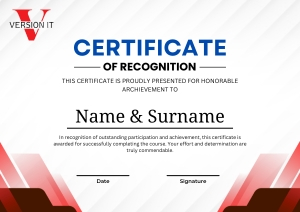Home > Courses > Popular Courses > AWS data engineering and data analytics Course
AWS data engineering in
Hyderabad
Currently, there is a very high demand in the market for qualified professionals in AWS data engineering because of the rapidly changing technological environment. Our complete AWS Data Engineer training in Hyderabad helps you gain the necessary know-how for a competitive edge in today’s fast-paced field.
21 Modules
with Certifications
Certificate
After Completion
English
Language
Why do we call it AWS data engineering?
The profession of skilled data handling and processing is known as Data Engineering for AWS. Such a field is crucial to organizations that would like to make sense out of collected information, conserve space for storage, and employ a data-driven approach. With more companies moving their operations to the cloud platforms, it is imperative that the work of AWS data engineers be effective for streamlined managing and utilizing of the data. Industry professionals design AWS Data Engineering training in Hyderabad. The participants are taught basics of AWS services such as provisioning of database functionality, storage and data analysis comprising of AWS glue, Amazon Redshift, and ML tool integration respectively. The theory is integrated with practice through practical projects and case studies that prepare learners to professionally integrate.
Why should you attend Version IT AWS data engineer training in Hyderabad?
The modern-day AWS Data Engineers’ course is offered by Hyderabad’s IT Version at a Center that offers quality, industry-relevant material and a networked platform for knowledge sharing. Participation in this course equips individuals with the skills they need as competent professionals who will address data-oriented challenges hence leading to career promotion or new paths in data engineering.
Topics You will Learn
An Introduction to Data Engineering
- The rise of big data as a corporate asset
- The challenges of ever-growing datasets
- Data engineers – the big data enablers
- Understanding the role of the data engineer
- Understanding the role of the data scientist
- Understanding the role of the data analyst
- Understanding other common data-related roles
- The benefits of the cloud when building big data analytic solutions
Data Management Architectures for Analytics
- The evolution of data management for analytics
- Databases and data warehouses
- Dealing with big, unstructured data
- A lake on the cloud and a house on that lake
- Understanding data warehouses and data marts –fountains of truth
- Distributed storage and massively parallel processing
- Columnar data storage and efficient data compression
- Dimensional modeling in data warehouses
- Understanding the role of data marts
- Feeding data into the warehouse – ETL and ELT pipelines
- Building data lakes to tame the variety and volume of big data.
- Data lake logical architecture
- Bringing together the best of both worlds with the lake house architecture
- Data lakehouse implementations
- Building a data lakehouse on AWS
- Hands-on – configuring the AWS.
- Command Line Interface tool and creating an S3 bucket.
- Installing and configuring the AWS CLI
- Creating a new Amazon S3 bucket
The AWS Data Engineer's Toolkit AWS services for ingesting data
- Overview of Amazon Database Migration Service (DMS)
- Overview of Amazon Kinesis for streaming data ingestion
- Overview of Amazon MSK for streaming data ingestion
- Overview of Amazon AppFlow for ingesting data from SaaS services
- Overview of Amazon Transfer Family for ingestion using FTP/SFTP protocols
- Overview of Amazon DataSync for ingesting from on-premises storage
- Overview of the AWS Snow family of devices for large data transfers
AWS services for transforming data
- Overview of AWS Lambda for light transformations
- Overview of AWS Glue for serverless Spark processing
- Overview of Amazon EMR for Hadoop ecosystem processing
AWS services for orchestrating big data pipelines
- Overview of AWS Glue workflows for orchestrating Glue components
- Overview of AWS Step Functions for complex workflows
- Overview of Amazon managed workflows for Apache Airflow
AWS services for consuming data
- Overview of Amazon Athena for SQL queries in the data lake
- Overview of Amazon Redshift and Redshift Spectrum for data warehousing and data lakehouse architectures
- Overview of Amazon Quick Sight for visualizing data
Ingesting Batch and Streaming Data
- Understanding data sources
- Data variety
- Data volume
- Data velocity
- Data veracity
- Data value
- Questions to ask.
- Ingesting data from a relational database
- AWS Database Migration Service (DMS)
- AWS Glue
- Other ways to ingest data from a database.
Hands-on – triggering an AWS Lambda function when a new file arrives in an S3 bucket
- Creating a Lambda layer containing the AWS Data Wrangler library
- Creating new Amazon S3 buckets
- Creating an IAM policy and role for your Lambda function
- Creating a Lambda function
- Configuring our Lambda function to be triggered by an S3 upload
Data Cataloging, Security, and Governance
- Getting data security and governance right
- Common data regulatory requirements
- Core data protection concepts
- Personal data
- Encryption
- Anonymized data
- Pseudonymized data/tokenization
- Authentication
- Authorization
Cataloging your data to avoid the data swamp.
- How to avoid the data swamp
Ingesting streaming data
- Amazon Kinesis versus Amazon
- Managed Streaming for Kafka (MSK)
- Hands-on – ingesting data with AWS DMS
- Creating a new MySQL database instance
- Loading the demo data using an Amazon EC2 instance
- Creating an IAM policy and role for DMS
- Configuring DMS settings and performing a full load from MySQL to S3
- Querying data with Amazon Athena
- Hands-on – ingesting streaming data
- Configuring Kinesis Data Firehose for streaming delivery to Amazon S3
- Configuring Amazon Kinesis Data Generator (KDG)
- Adding newly ingested data to the Glue Data Catalog
- Querying the data with Amazon Athena
Identifying and Enabling Data Consumers
- Understanding the impact of data democratization
- A growing variety of data consumers
- Meeting the needs of business users with data visualization
- AWS tools for business users
- Meeting the needs of data analysts with structured reporting
- AWS tools for data analysts
- Meeting the needs of data scientists and ML models
- AWS tools used by data scientists to work with data.
- Hands-on – creating data transformations with AWS Glue DataBrew
- Configuring new datasets for AWS Glue DataBrew
- Creating a new Glue DataBrew project 2
- Building your Glue DataBrew recipe
- Creating a Glue DataBrew job
Orchestrating the Data Pipeline
- What is a data pipeline, and how do you orchestrate it?
- How do you trigger a data pipeline to run?
- How do you handle the failures of a step in your pipeline?
- Examining the options for orchestrating pipelines in AWS
- AWS Data Pipeline for managing ETL between data sources.
- AWS Glue Workflows to orchestrate Glue resources.
- Apache Airflow as an open-source orchestration solution
- Pros and cons of using MWAA.
- AWS Step Function for a serverless orchestration solution
- Pros and cons of using AWS Step Function
- Deciding on which data pipeline orchestration tool to use
- Hands-on – orchestrating a data pipeline using AWS Step Function
- Creating new Lambda functions
Ad Hoc Queries with Amazon Athena
- Amazon Athena – in-place SQL analytics for the data lake
- Tips and tricks to optimize Amazon Athena queries.
- Common file format and layout optimizations
- Writing optimized SQL queries
- Federating the queries of external data sources with Amazon Athena Query Federation
- Querying external data sources using Athena Federated Query
- Managing governance and costs with Amazon Athena Workgroups
- Athena Workgroups overview
- Enforcing settings for groups of users
- Enforcing data usage controls
- Hands-on – creating an Amazon Athena workgroup and configuring Athena settings.
- Hands-on – switching Workgroups and running queries.
- IAM roles for Redshift
- Creating a Redshift cluster
- Creating external tables for querying data in S3
- Creating a schema for a local Redshift table
- Running complex SQL queries against our data
Visualizing Data with Amazon Quick Sight
Representing data visually for maximum impact
- Benefits of data visualization
- Popular uses of data visualizations
Understanding Amazon Quick Sight’s core concepts
- Standard versus enterprise edition
- SPICE – the in-memory storage and computation engine for Quick Sight
Ingesting and preparing data from a variety of sources
- Preparing datasets in Quick Sight versus performing ETL outside of Quick Sight
Creating and sharing visuals with Quick Sight analyses and dashboards
- Visual types in Amazon Quick Sight
AWS services for data encryption and security monitoring
- AWS Key Management Service (KMS)
- Amazon Macie
- Amazon GuardDuty
- Pass
- Return
- Case studies
AWS services for managing identity and permissions.
- AWS Identity and Access Management (IAM) service
- Using AWS Lake Formation to manage data lake access.
Hands-on – configuring Lake Formation permissions.
- Creating a new user with IAM permissions
- Transitioning to managing fine-grained permissions with AWS Lake Formation
Transforming Data to Optimize for Analytics
- Creating a new user with IAM permissions
- Transitioning to managing fine-grained permissions with AWS Lake Formation
Loading Data into a Data Mart
- Extending analytics with data warehouses/data marts
- Cold data
- Warm data
- Hot data
- What not to do – anti-patterns for a data warehouse
- Using a data warehouse as a transactional datastore
- Using a data warehouse as a data lake
- Using data warehouses for real-time, record-level use cases
- Storing unstructured data
Redshift architecture review and storage deep dive
- Data distribution across slices
- Redshift Zone Maps and sorting data
- Designing a high-performance data warehouse
- Selecting the optimal Redshift node type
- Selecting the optimal table distribution style and sort key
- Selecting the right data type for columns
- Selecting the optimal table type
- Moving data between a data lake and Redshift
- Optimizing data ingestion in Redshift
- Exporting data from Redshift to the data lake
- Hands-on – loading data into an Amazon Redshift cluster and running queries Uploading our sample data to Amazon S3
- IAM roles for Redshift
- Creating a Redshift cluster
- Creating external tables for querying data in S3
- Creating a schema for a local Redshift table
- Running complex SQL queries against our data
Let Your Certificates Speak

- Certified in AWS Data Analytics: Mastering Data Insights with Cloud-based Solutions.
- Certificates are globally recognized & they upgrade your programming profile.
- Certificates are generated after the completion of course.
All You Need to Start this Course
- Engaging and interactive course content.
- Expert-led instruction for a deeper understanding.
Testimonials




Still Having Doubts?
An AWS Data Engineer is in charge of developing, deploying, and maintaining AWS data processing systems and infrastructure. Data ingestion, storage, transformation, and analysis are examples of such jobs.
AWS offers a variety of data engineering services, including Amazon S3 (Simple Storage Service), Amazon Redshift (data warehouse), AWS Glue (ETL service), and Amazon EMR (Elastic MapReduce).
Amazon S3 is a scalable object storage service used to store and retrieve massive volumes of data. S3 is frequently used by data engineers as a data lake for storing raw and processed data.
An entirely managed extract, transform, and load (ETL) service is AWS Glue. Data engineers use ETL operations to automate the process of preparing and converting data for analysis using Amazon Glue.


